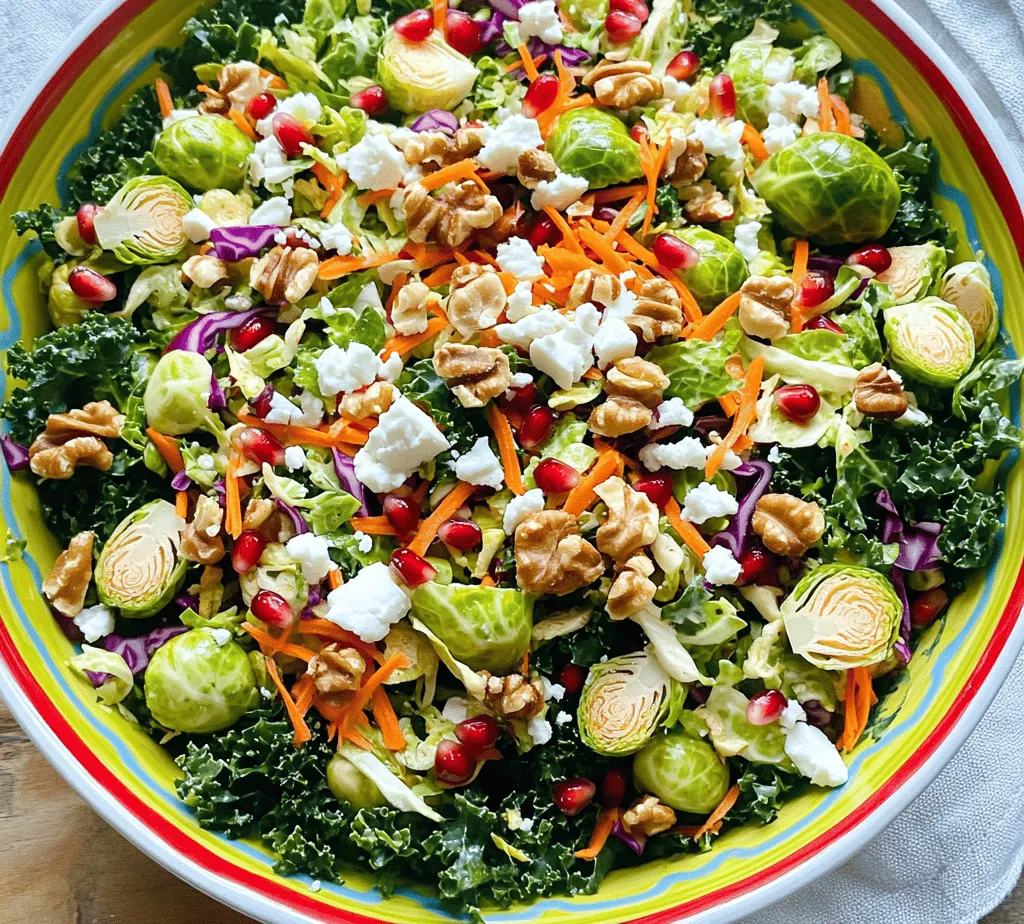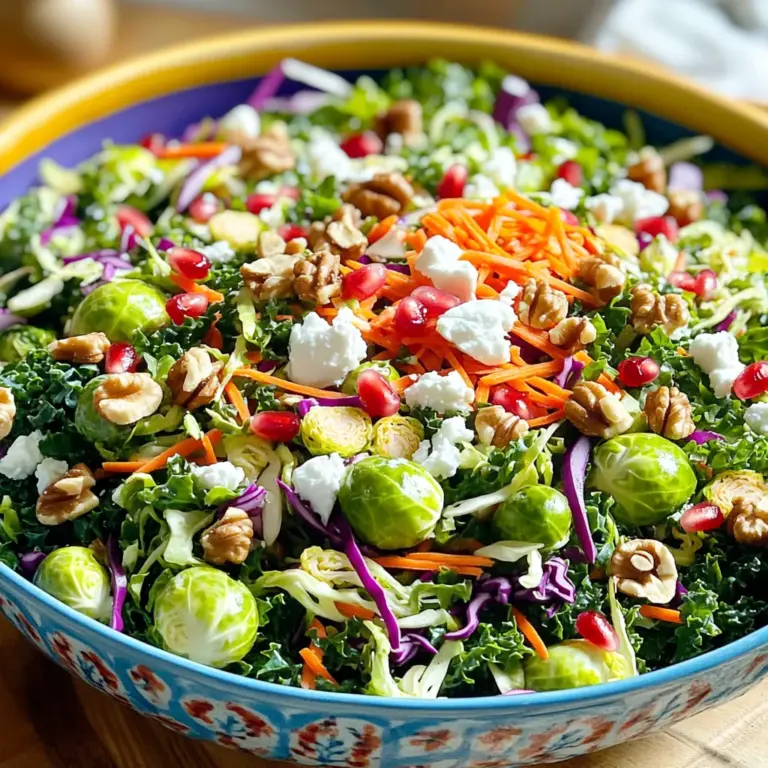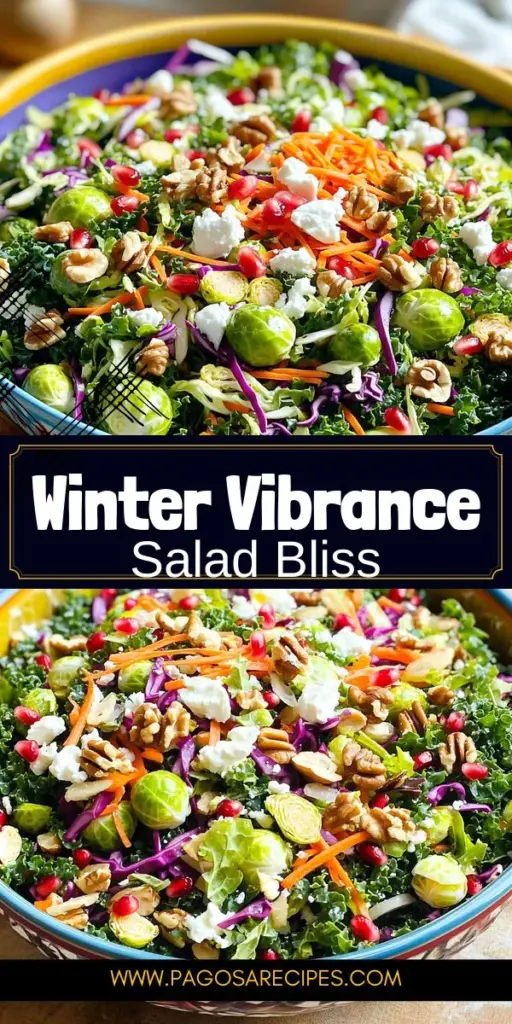As the cold winter months set in, many of us might gravitate towards hearty, warming meals. However, incorporating seasonal salads into our winter diet can be both nourishing and refreshing. The Winter Chopped Salad is an excellent option to brighten up your plate during this chilly season. This delightful salad is not only visually appealing, with its vibrant colors, but it is also packed with essential nutrients that promote overall health and well-being.
Salads are often thought of as light, summer fare, but winter salads can be just as satisfying and nutritious. The Winter Chopped Salad combines a variety of seasonal ingredients that offer a delightful crunch alongside a medley of flavors. This salad is versatile; it can serve as a standalone meal or complement a larger feast. With each bite, you’ll experience a satisfying combination of textures and tastes, making this salad a must-try during the colder months.
One of the key appeals of the Winter Chopped Salad is its health benefits. Each ingredient contributes a unique assortment of vitamins, minerals, and antioxidants that support a healthy lifestyle. From leafy greens to crunchy nuts and vibrant fruits, this salad is designed to nourish your body while tantalizing your taste buds.
Understanding the Ingredients
The foundation of any great salad lies in its ingredients. The Winter Chopped Salad features a variety of wholesome components, each with its own set of nutritional benefits. Let’s dive into the specifics of these ingredients and explore how they contribute to your health:
Kale
Kale is a nutritional powerhouse that deserves the spotlight in any winter salad. This leafy green is rich in vitamins A, C, and K, which are crucial for maintaining a robust immune system and promoting healthy skin. Kale is also an excellent source of fiber, which aids in digestion and keeps you feeling full longer. When incorporated into the Winter Chopped Salad, it provides a hearty base while enhancing the overall nutrient profile of the dish.
Brussels Sprouts
Often underestimated, Brussels sprouts are a fantastic addition to any winter salad. These little cabbages are high in fiber and antioxidants, which work together to support heart health and combat oxidative stress. They also contain essential vitamins such as vitamin C and vitamin K, which play vital roles in immune function and blood clotting. When chopped and tossed into the salad, Brussels sprouts provide a unique flavor and a satisfying crunch.
Red Cabbage
The vibrant shade of red cabbage adds both color and nutrition to the Winter Chopped Salad. Packed with vitamins and antioxidants, red cabbage boasts anti-inflammatory properties that can help reduce the risk of chronic diseases. Its high fiber content supports digestive health, making it an excellent choice for a balanced salad. The crisp texture of red cabbage complements the other ingredients beautifully, creating a salad that is as pleasing to the eye as it is to the palate.
Carrots
Carrots are not only sweet and crunchy but also an excellent source of beta-carotene, a powerful antioxidant that the body converts into vitamin A. This vitamin is essential for maintaining good vision, promoting skin health, and supporting the immune system. Including carrots in the Winter Chopped Salad not only enhances its flavor but also provides a natural sweetness that balances the other ingredients.
Pomegranate Seeds
These jewel-like seeds are a true winter delight. Pomegranate seeds are loaded with antioxidants, which help reduce inflammation and protect the body from free radicals. They are also rich in vitamins C and K, making them a beneficial addition to the salad. The burst of flavor from pomegranate seeds adds a delightful contrast to the crunch of the vegetables, creating a harmonious blend of tastes.
Walnuts
Adding walnuts to the Winter Chopped Salad introduces healthy fats that are beneficial for heart and brain health. These nuts are rich in omega-3 fatty acids, which have been linked to improved cognitive function and reduced risk of heart disease. Walnuts also provide a satisfying crunch that elevates the texture of the salad. With their rich flavor, they serve as a nutritious topping that ties all the flavors together.
Feta Cheese
Feta cheese brings a tangy depth of flavor to the Winter Chopped Salad. Not only does it enhance the taste, but it is also lower in fat than many other cheese options, making it a healthier choice. Feta is a good source of calcium, which is essential for strong bones. When crumbled over the salad, it adds a creamy contrast to the crisp vegetables, creating a delightful balance of flavors.
Olive Oil
A staple in Mediterranean diets, olive oil is known for its heart-healthy monounsaturated fats. This oil is not only delicious but also packed with antioxidants that promote overall health. Drizzling high-quality olive oil over the Winter Chopped Salad enhances the flavors of the ingredients while providing a boost of healthy fats that support cardiovascular health.
Apple Cider Vinegar
Apple cider vinegar is a popular ingredient known for its potential health benefits. It may aid digestion and help balance blood sugar levels, making it a great addition to the salad dressing. The tangy flavor of apple cider vinegar complements the sweetness of the other ingredients, creating a well-rounded flavor profile that elevates the salad.
Honey
A touch of honey adds a natural sweetness to the Winter Chopped Salad dressing. This natural sweetener contains antioxidants and can provide a quick energy boost. When combined with the other dressing ingredients, honey balances the acidity of the vinegar and enhances the overall flavor of the salad.
Dijon Mustard
Dijon mustard is not just a condiment; it is a flavorful addition to salad dressings that can aid in digestion. Its sharpness adds a delightful kick to the Winter Chopped Salad dressing, enhancing the overall taste. Just a small amount can elevate the salad, providing depth and complexity to each bite.
Preparation Overview
The preparation of the Winter Chopped Salad is straightforward, making it accessible for home cooks of all levels. To create a vibrant and flavorful salad, it is vital to prep the ingredients properly. The process begins with selecting fresh, seasonal produce, which ensures that your salad is as nutritious as possible.
Start by washing and drying the kale and Brussels sprouts thoroughly. Remove the tough stems from the kale and chop the leaves into bite-sized pieces. For the Brussels sprouts, trim the ends and slice them thinly, allowing their natural sweetness to shine through.
Next, finely shred the red cabbage and julienne the carrots, taking care to maintain uniformity in size for even distribution of flavors. The pomegranate seeds can be removed from the fruit with ease, or you can purchase them pre-packaged for convenience.
Once all the vegetables are prepped, the next step involves combining them in a large bowl, allowing for ample mixing and tossing. This is where you can get creative; feel free to adjust the proportions based on your preferences.
The final step involves preparing the dressing, which ties all the elements of the salad together. Whisk together the olive oil, apple cider vinegar, honey, Dijon mustard, salt, and pepper in a separate bowl until well blended. Drizzle the dressing over the salad just before serving, ensuring that every ingredient is lightly coated for optimal flavor.
By following these preparation steps, you will create a Winter Chopped Salad that not only looks stunning but is also bursting with flavor and nutrition. Each ingredient plays a crucial role in making this dish a perfect choice for a winter meal, whether enjoyed as a light lunch or as a complement to dinner.
As the season unfolds, embrace the opportunity to enjoy this nourishing and vibrant salad. It’s a perfect way to celebrate winter produce while supporting your health, one delicious bite at a time.

Chopping and Shredding Techniques for Greens and Vegetables
When it comes to crafting a vibrant winter chopped salad, the way you chop and shred your ingredients can make a significant difference in both texture and presentation. Start with your greens: sturdy options like kale or romaine are excellent choices for winter salads. To prepare these greens, remove the tough stems and tear or chop the leaves into bite-sized pieces. A sharp knife is essential for clean cuts, which helps maintain the freshness and nutrients of the greens.
For vegetables such as bell peppers, carrots, and cucumbers, consider using a julienne or dicing technique. A julienne cut involves slicing vegetables into thin matchstick shapes, which not only adds visual appeal but also ensures that every bite is packed with flavor. Dicing creates uniform cubes, which can enhance the overall texture of the salad. When chopping, try to keep the sizes consistent; this helps all ingredients blend harmoniously.
For ingredients like red cabbage or Brussels sprouts, a simple shredding technique works best. A sharp knife or mandoline slicer can create thin, even slices that add crunch and color to your salad. Remember to wash all your vegetables thoroughly before cutting to remove any dirt or pesticides, ensuring a clean and healthy salad.
Tips for Toasting Walnuts for Enhanced Flavor
Toasting walnuts is a simple yet impactful way to elevate the flavor of your winter chopped salad. The process enhances their natural oils, resulting in a deeper, richer flavor that adds a delightful crunch to your dish. Here’s how to do it:
1. Preheat your oven: Begin by preheating your oven to 350°F (175°C).
2. Spread walnuts evenly: Place the walnuts in a single layer on a baking sheet. Spread them out evenly to ensure they toast uniformly.
3. Toast in the oven: Bake for about 8-10 minutes, stirring halfway through to prevent burning. Keep a close eye on them; nuts can go from perfectly toasted to burnt in a matter of minutes.
4. Cool before using: Once toasted, remove them from the oven and let them cool. This step is important as it allows the walnuts to maintain their crunch when mixed into the salad.
Crafting the Perfect Dressing
The dressing is a crucial component of any salad, and it can make or break the overall flavor profile of your winter chopped salad. A well-balanced dressing enhances the freshness of the vegetables and brings all the ingredients together.
Making the Dressing
To create a delicious dressing, you will need the following ingredients:
- 1/4 cup olive oil
- 2 tablespoons apple cider vinegar
- 1 tablespoon honey (or maple syrup for a vegan option)
- 1 teaspoon Dijon mustard
- Salt and pepper to taste
1. Combine ingredients: In a small bowl or jar, combine the olive oil, apple cider vinegar, honey, and Dijon mustard.
2. Whisk or shake: Whisk the mixture until it’s well combined, or seal the jar and shake it vigorously.
3. Taste and adjust: Before serving, taste the dressing and adjust the seasoning. This is where the balance of flavors comes into play; you want a good mix of acidity from the vinegar, sweetness from the honey, and a hint of salt.
Importance of Balancing Flavors
Achieving a perfect salad dressing is all about balance. The acidity of the vinegar should complement the sweetness of the honey, while the saltiness enhances the overall flavor. If your dressing leans too acidic, add a touch more honey. If it tastes too sweet, a splash of vinegar can help. The key is to taste as you go and find the right combination that pleases your palate.
Tossing and Serving the Salad
Once your salad ingredients are prepped and your dressing is ready, it’s time to toss everything together. Here are some best practices for combining your salad without bruising the greens:
1. Combine ingredients in a large bowl: Start by adding the chopped greens, vegetables, and toasted walnuts to a large mixing bowl.
2. Add the dressing gradually: Drizzle the dressing over the top, but don’t pour it all at once. This allows you to control how much dressing you want on your salad.
3. Toss gently: Use two large serving spoons or salad tongs to gently toss the salad. The goal is to coat every piece without crushing the greens.
Allow the salad to sit for about 10-15 minutes before serving. This resting period allows the flavors to meld, making each bite more flavorful.
Presentation Ideas
Presentation plays a key role in enjoying a meal. For your winter chopped salad, consider serving it in a colorful bowl that contrasts with the vibrant ingredients. This not only enhances the visual appeal but also makes the salad more inviting.
To elevate the presentation further, garnish the salad with extra pomegranate seeds, crumbled feta cheese, and a sprinkle of the toasted walnuts just before serving. This adds a pop of color and texture, making your salad not only delicious but also visually stunning.
Health Benefits of Eating Seasonal Salads
Incorporating seasonal ingredients into your winter chopped salad has numerous health benefits. Winter vegetables are often packed with nutrients that support your immune system, which is particularly important during the colder months when colds and flu are more prevalent. Ingredients like kale, Brussels sprouts, and root vegetables are rich in vitamins A, C, and K, as well as antioxidants that help fend off illnesses.
Eating a variety of seasonal produce also ensures a diverse intake of nutrients, promoting overall health. Winter salads can be a great way to incorporate these nutrient-dense foods into your diet, making it easier to maintain a balanced and healthy eating plan.
Moreover, the act of preparing and enjoying fresh, homemade salads brings a sense of satisfaction and connection to your food. It encourages mindfulness in eating and can foster a positive relationship with wholesome ingredients.
Conclusion
The Winter Chopped Salad is not just a meal; it’s a celebration of winter’s bounty, bringing together a delightful mix of flavors, textures, and vibrant colors. From the crunch of fresh vegetables to the rich, nutty flavor of toasted walnuts and the perfect dressing, this salad is a versatile dish that’s both satisfying and nutritious.
As you embrace seasonal produce, remember the importance of enjoying the process of preparing your meals. Homemade salads allow you to experiment with flavors, customize ingredients to your liking, and ultimately enjoy the satisfaction of creating something healthy for yourself and your loved ones.
So gather your ingredients, don your apron, and dive into the joy of making this winter chopped salad. You’ll not only nourish your body but also delight in the flavors of the season, creating a dish that can be shared and savored together. Happy cooking!



